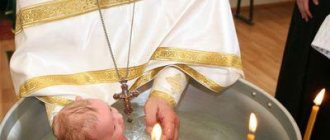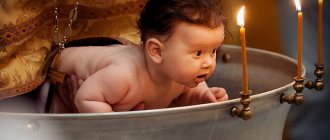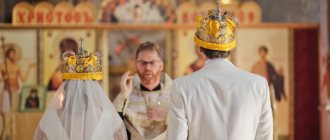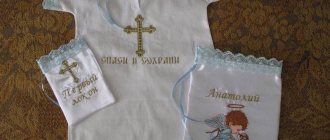Church rules
“Any Christian could baptize a baby in case of urgent need, observing the rules of baptism (the necessary words and triple immersion).
Church rules state:
The right to perform the Sacrament of Baptism belongs primarily to the parish priest, legally ordained and not under prohibition.
To baptize his own child, according to the Nomocanon, a priest should invite another priest, but in extreme cases he can baptize his child himself.
However, a dangerously ill child can be baptized in the absence of a priest by a deacon, a psalm-reader, or even a layman: a man or a woman.
A layman who, out of necessity, has taken upon himself to perform the Sacrament of Baptism must be a believing Christian and be aware of the importance of this Sacrament.
He must correctly pronounce: “The servant of God (servant of God, name) is baptized in the name of the Father (first immersion), and the Son (second immersion), and the Holy Spirit” (third immersion).
Entry in the birth register of Maria Kopteva on March 7, 1914, note: baptized by a midwife.
How was such a baptism registered?
Upon recovery, a person baptized in this way must be taken to the priest along with the person who performed the Baptism. The priest, having conducted a survey about the completion of the sacrament, only completes Baptism and Confirmation.
The priest must perform the Sacraments of Baptism and Confirmation according to the usual rites if:
- The baptism was not performed according to the rules (not in three immersions, with a distorted or even incorrect sacramental formula).
- The person who has performed Baptism is an unbeliever, unbaptized or a non-believer (Muslim, Judaist, Buddhist).
Read stories about family on the Yandex Zen channel
Rebaptism
A priest should baptize a person if it is not possible to verify the fact of baptism. The second Baptism out of ignorance is not imputed to the person being baptized.
The same should be done when the baby was allegedly baptized by a layman, but it was not possible to establish whether the Sacrament was performed correctly.
Everything for the Orthodox Baptism of a child
The cost of products is determined by the exceptional quality of the skillful work of our craftswomen, materials and accessories. Our baptismal sets are distinguished by smooth and technologically advanced seams, clear patterns that correspond to the size chart, original embroidery patterns, high-quality natural fabrics and decorative elements used in the production of baptismal clothing.
The price-quality ratio in our products is optimal. Being a workshop, we do not make additional markups on our goods, as is the case with online stores that engage in resale.
The cost directly determines the quality of materials and tailoring. We sew baptismal clothes in our own production with professional equipment and mandatory quality control control.
We use exclusively natural cotton and linen fabrics, soft woven lace made from cotton thread, fluffy terry made from 100% cotton fiber. We order them only from certain “trusted” factories in the countries of the former USSR and Europe.
The embroidery on our products is neat, even, and dense. Patterns with gold and silver on the reverse side always have a cotton lining that prevents the metallized thread from coming into contact with the child’s skin. The seams are hidden as much as possible, which gives the products an external lightness and elegance and makes them comfortable.
Our economy class models have a lower price, but only due to more modest finishing and inexpensive calico - also 100% cotton fabric. At the same time, most buyers choose baptismal sets made from mid-price fabrics - cotton muslin, satin, blouse linen, with beautiful lace trim and rich embroidery. Because cost is not the main criterion for choosing for a bright event that happens only once in a lifetime.
Elegant christening clothes make the baby's image festive and look impressive in photos and videos. In addition, it is customary to carefully store accessories after Baptism as a memory of the bright Sacrament. They are periodically taken out and examined, remembering important moments from the life of the family. It’s nice if things don’t lose their beauty over the years and can even be inherited from parents to children. Our products are from this category; they will provide you with warm memories.
You may find similar-looking baptismal sets from your competitors that are cheap. But the main difference is in the fabrics, which is difficult to catch from the photo. To avoid any confusion, each item in the description has a short video that demonstrates the quality of the material and other features of the model.
Also, most stores do not bother with the correct configuration and decent packaging, just to attract the buyer with the lowest possible price. But for godparents, the packaging will be an important component, because they are buying a set for their godson as a gift. Therefore, all our products are packaged in a branded bag and a beautiful box with a transparent window and gold embossing, supplemented with useful information and a prayer card. Pectoral crosses always come with a free light cotton rope and a packaging envelope with a ribbon.
Baptism by midwife
I only read about baptism by someone other than a priest.
Imagine my surprise when in one register book I came across 3 unusual entries at once! In January and twice in March, the babies were baptized by the midwife.
Here is an example of such a note to the metric record of the birth of Mikhail Golovin on March 10, 1914. It is indicated that the baby was baptized by a midwife.
Metric record of the birth and sacrament of baptism on March 10, 1914 of the baby Michael. It is indicated that it was loaded by a peasant grandmother from the village of Taparki-Burovoy.
Sacrament of Baptism
| The sacrament of baptism. - M.: Sretensky Monastery Publishing House, 2010. - 32 p. — (Series “Sacraments and Rites”). |
The Holy Church calls baptism the second birth.
In this brochure the reader will find the necessary information about the sequence of baptism and the deep meaning of this church Sacrament. Here is an excerpt from the book.
Introduction
In our time, when the traditions of education in faith have been largely lost, a person most often comes to God through sorrows or moral quests. Tired of the fragility of material values and the relativity of spiritual values, we seek support in Christ, in His saving commandments and comforting promises. Often the desire to be baptized arises in people who do not know the Orthodox teaching to the proper extent, nevertheless they recognize the high moral authority of the Orthodox Church and want to join in its sacredness and grace.
Entry into the Church, otherwise called churching, begins with the Sacrament of holy baptism - the first of the seven Sacraments of the Church. It is also called the second (spiritual) birth.
The very word “Sacrament” suggests that the Lord Himself is mysteriously (invisibly) present in this action, which is how it differs from a ritual or tradition, and the priest only plays the role of a mediator or witness, as one of the prayers says, between the believer and God .
In the Gospel the Lord commands: truly, truly , I say to you, unless someone is born of water and the Spirit, he cannot enter the Kingdom of God. That which is born of the flesh is flesh, and that which is born of the Spirit is spirit
(John 3:5-6). So, baptism is the Sacrament of spiritual birth.
In baptism, a person mysteriously dies to sins and passions (renounces serving them) and is resurrected together with Christ for a new life leading to eternal life. All this suggests that baptism is an event as important as the birth of a person.
Baptism first of all cleanses a person from all his sins, voluntary and involuntary. The soul emerges from the baptismal font renewed and enlightened. For a baby just born into this world, it is also important to cleanse the nature damaged by sin, which he, unfortunately, invariably inherits from his parents.
The sacrament of baptism originates from the Savior’s commandment given to the apostles: Go and teach all nations,
baptizing them in the name of the Father and the Son and the Holy Spirit, teaching them to observe everything that I have commanded you; and lo, I am with you always, even to the end of the age
(Mt 28:19-20).
These amazing words of Christ are dear to every believing heart, but at the same time we hear that a person needs to know the teaching that he accepts and learn to keep the commandments of Christ.
Since ancient times, baptism was preceded by familiarization with the saving teachings of our Church. In the early Church, preparation for baptism took from several months to three years. Those preparing to receive this Sacrament gradually comprehended the life of the Church, studied the Holy Scriptures, the foundations of faith, and participated in common prayer (but not in the Church Sacraments). Baptism was then performed on Easter, and subsequently this preparation gave rise to the pre-Easter period, which came to be called Great Lent.
Now the Sacrament of baptism is performed throughout the year, so those preparing to receive baptism must first of all have an ardent desire to follow Christ and live the life of the Church, that is, to participate in the Church Sacraments, in worship, in prayer and fasting.
Usually, someone coming to be baptized is required to know at least the Creed - a brief summary of the truths of Christianity, the commandments of God - the basics of Christian life and the Lord's Prayer. Catechetical, or catechetical, conversations are often held at churches to help those wishing to be baptized. In any case, it is possible to seek clarification from a priest.
This certainly applies only to adult members of the Church. Children cannot yet understand the accepted teaching and consciously unite with Christ, therefore, when the Sacrament is performed over children whose parents are believers and intend to raise their children in the Orthodox faith, godparents are elected.
Who is the midwife?
Midwife, midwife - a woman who helped a woman in childbirth, and then washed the baby and looked after him for several days after birth.
Her duties included cutting the umbilical cord and then washing the baby.
Different regions of the Russian state had their own traditions. For example, in the central part of Russia, it was necessary to cut a boy’s umbilical cord on an oak board or an ax handle, and for a girl on an alder board or spindle. The belief assumed that the boy would be an excellent craftsman, and the girl an excellent needlewoman.
The midwife tied the umbilical cord with a linen thread intertwined with a few hairs from the parents.
Infant Baptism
The Sacrament of Infant Baptism is preceded by a series of prayers: prayers to the mother in labor and prayers when naming the baby. In prayers to the mother in labor, the priest asks the Lord to forgive the sins of the baby’s mother, restore her health after childbirth, and preserve her life and the life of the baby. In the prayer when naming the baby, the priest prays that the baby will spend his life according to God’s commandments and will be worthy to receive the Kingdom of Heaven. The baby is given the name of the saint as a sign that he is accepted into the union of the heavenly and earthly Church and must follow in the footsteps of the saint in deeds of good that lead from the earthly Church to the heavenly Church.
In the 15th century, the custom of having two godparents (godparents) appeared in Rus'. This innovation was actively denounced by Metropolitan Photius of Kiev and All Rus' (XIV century - 1431). According to ancient canons, there had to be one recipient, respectively: a man for a boy and a woman for a girl. Nevertheless, the tradition of having two successors has taken root in Rus', and is still followed.
Plan of public conversations
- 1st conversation. The sacred history of the Old Testament.
- 2nd conversation. The sacred history of the New Testament.
- 3rd conversation . Fundamentals of Orthodox doctrine (Creed and basic prayers).
- 4th conversation: The structure of an Orthodox church and the meaning of worship.
- 5th conversation . Church sacraments.
You can sign up for public talks by calling: +7 (916) 508-72-51.
Epiphany 2021: do's and don'ts.
On January 19, Orthodox Christians celebrate the great holiday - Epiphany. What are the traditions of this day, what must be done, and what is strictly prohibited?
Epiphany completes the cycle of winter holidays and Christmastide, which last from January 7 to January 19. The holiday begins on January 18, Epiphany Eve, when the first blessing of water takes place. Baptism is also called the Feast of the Epiphany, since at the baptism of the Lord, the Most Holy Trinity appeared to the world.
At Epiphany, you should go to church, pray and bless the water, and also congratulate all your family and friends on Epiphany.
Water blessed on this day has truly magical properties: it cleanses from illnesses and bad thoughts.
Be sure to collect holy water and keep it at home all year. Believers, every morning after prayer, drink a teaspoon of holy water on an empty stomach.
At Epiphany, people plunge into the ice hole, but this must be done after visiting church and receiving communion. People said that sick people were immersed in Epiphany to be healed, and those who put on masks for the New Year to get rid of sin.
On this day, the whole family gathers at the festive table and, according to tradition, the first to try the food is the one who plunged into the ice hole last.
At Epiphany there was a very beautiful ritual of releasing doves. White doves symbolized the end of the holidays, which must be released into freedom.
What to do on Epiphany ?
In order to feel the mystery of the holiday, even those who do not fast, should at least limit themselves to food on Christmas Eve. Alcohol and cigarettes are strictly prohibited. On the evening of January 18, you need to go to the evening service at the temple or to the consecration of a reservoir located nearby. After this, you can have dinner, gathering your closest people at the table. But loud noise, music and noisy fun are unacceptable. In the morning, be sure to wash your face with holy water, wipe your body with it, and take three sips on an empty stomach. If possible, you need to attend the morning service, take communion after it, and when you come home, have breakfast. The hostess must enter the house first. She sprinkles the house with holy water, and draws crosses in chalk on the front door and in the corners of the rooms. After such a procedure, not a single person with reckless thoughts will come close to the home. The rest of the day is meant to rest and enjoy. By “rejoice” is meant spiritual grace. Take a walk with your children, visit your parents and other relatives. If you can’t go visit, at least call them.
What not to do at Epiphany
On this big holiday, it is forbidden to quarrel and swear, to be angry with family and friends.
Any physical labor, all housework and crafts (sewing, knitting, embroidery) are prohibited.
On this day, housewives always blessed the house with holy water, ventilated it, and scattered salt in the corners to protect the house from evil spirits.
On the holiday, you cannot gossip, slander, or do mean things to other people, otherwise everything will turn against you with triple force.
Adult Baptism
Nowadays, when after many years of fighting against God, the Orthodox faith is returning to people’s lives, many come to God as adults. The desire to be baptized as an adult presupposes that a person understands that baptism is not just a fashionable rite, not a tribute to tradition, but a Sacrament, during which he is not simply immersed in water and puts on a cross, but is born for a new life in Christ, leaving the old sinful life is like old clothes. After all, the snow-white shirt that is put on the newly baptized is a symbol of a new life, clean from filth and sins. Baptism accepted “because everyone else is doing it” will not have real power, since the main requirement for adults who wish to be baptized is sincere faith. If a child is baptized based on the faith of his parents and the hope that the parents and godparents will raise the child in the spirit of Orthodoxy, then an adult does not have to have godparents, since it is believed that he himself is able to find the right path in life and walk the road to God.
An obligatory part of the preparation for the Sacrament is catechetical conversations, during which the foundations and postulates of the Orthodox faith, as well as the moral and moral aspects of human life are explained. Such conversations are a kind of “introductory course” into the basis of the Orthodox faith and into the spiritual life of a person. Before baptism itself, a person must keep a strict fast for three days, abstain from smoking, alcohol and entertainment, and also make peace with everyone with whom he had quarrels. All these three days you also need to pray.
For baptism you need a new white shirt and a cross on a chain or cord, as well as a large towel. How is baptism performed? The sequence of the Sacrament was established many centuries ago and consists of the catechumen, the subsequent baptism, which, in turn, consists of the consecration of water, the consecration of oil, baptism and the vesting of the baptized person in baptismal clothing. After baptism, the Sacrament of Confirmation is performed. Since not all temples have the opportunity to install a font that can accommodate an adult, triple immersion can be replaced by dousing with water or sprinkling with it. During the catechumen, the person is given a baptismal name. The name is chosen from the calendar; for an adult, it is usually close in sound or meaning to the name already given at birth.
A baptized Christian must visit church annually on the day of baptism to confess and receive communion. In addition, the duty of every Orthodox person is to attend church services and observe fasts. If it is not possible to go to church every week, then you should at least attend holiday services.









